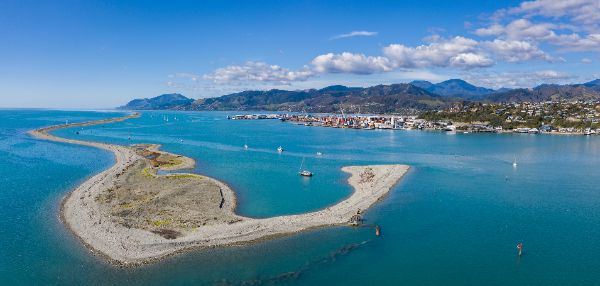
The Nelson-Tasman region is a quiet achiever on the commercial property front and now, after many years of flying under the radar, it’s finding favour with out-of-town investors as the chase for strong yields continues.
The region’s fiscal position has traditionally been underpinned by a strong primary sector and, while this still remains the case, it’s being bolstered by a flourishing knowledge and innovation economy.
The wider region – with an estimated residential population of 111,000 – is becoming more progressive and the rest of the country is taking notice, according to Bayleys Nelson director commercial and industrial, Paul Vining.
“The majority of commercial and industrial property stock has tended to be tightly-held either by local individuals and entities within the private sector, or by intergenerational iwi group Wakatū Incorporation, one of the largest private land owners in the top of the South Island.
“It has taken the emergence of an active development sector to kick-start real activity in the commercial and industrial property market, and attract outside investment.
“Despite significant new development in the wider region, there’s still a tangible shortage of property for sale – and that’s driving prices and yields.”
Vining said the industrial sector has been supercharged post-COVID.
Advertisement - scroll to continue reading“The pandemic, coupled with historically-low interest rates, a frenetic chase for yields, a shortage of available stock in other parts of New Zealand and this region’s strong economic performance – has revved up interest in industrial property with enquiry coming from all corners of the country.
“The short supply of industrial land in the broader region has hamstrung the property market to some extent, but rezoning has opened up tracts of land for new development and the buyers/occupiers are there for it.”
The Nelson-Tasman region encompasses the urban areas of Nelson City and suburbs, along with the Tasman District including the likes of Richmond, Wakefield, Motueka, Takaka, Golden Bay and Murchison.
The region clocked a GDP increase of 6.1 percent in the year to March 2020 – the largest increase in New Zealand equal with Bay of Plenty.
“The success and scale of the primary sector in the region means there is ample opportunity for supply chain and innovative businesses to grow, helping to create a diversified workforce and extending the demand for commercial and industrial property,” said Vining.
“There’s also an active drive by the Nelson Regional Development Agency to attract talent, visitors and investors to the region and to further sustainability goals.”
Port Nelson has just reported a strong financial position, with cargo volumes and container throughput remaining robust despite disruptors.
“Meanwhile, the region’s knowledge and innovation economy is definitely on the rise, which adds another string to the bow,” said Vining.
“The Cawthron Institute, New Zealand’s largest independent science organisation, has pushed research boundaries for a century and delivered world-class science to support the sustainable development of primary industries in New Zealand and worldwide.
“But now we also have Nelson-based creative knowledge spreading around the world with video producers Shuttlerock partnering with social platforms including Facebook, Instagram, Google, YouTube, Pinterest, TikTok, Hulu and Twitter.
“Add in the contribution made to the knowledge economy by the Nelson Marlborough Institute of Technology and the new Nelson Artificial Intelligence Institute, and Nelson is branching out.”
In partnership, Port Nelson and Cawthron Institute are looking to develop a science and technology innovation precinct on port-owned land in central Nelson, while new industrial precincts and mixed-use developments with commercial functions are emerging city-wide and, on its fringes, with Richmond seeing a surge of new activity.
Meanwhile, the $32 million redevelopment of Nelson Airport in 2019 shows the entity’s commitment to the region’s future. Its commercial manager, Simon Barr, said the airport’s master plan identifies considerable potential growth in both aviation activity and further opportunities for commercial development.
“The development of alternative revenue streams is a deliberate focus of Nelson Airport, “ he said.
“While this is not new, Covid-19 has elevated its importance, with an example of recent diversification being the introduction of Fitzgerald Construction to the airport community, where they are leasing a large hangar to prefabricate classrooms for a Ministry of Education contract.”



 John Mazenier: Gaffer Tape And Glue Delivering New Zealand’s Mission Critical Services
John Mazenier: Gaffer Tape And Glue Delivering New Zealand’s Mission Critical Services Earthquake Commission: Ivan Skinner Award Winner Inspired By Real-life Earthquake Experience
Earthquake Commission: Ivan Skinner Award Winner Inspired By Real-life Earthquake Experience Reserve Bank: Consultation Opens On A Digital Currency For New Zealand
Reserve Bank: Consultation Opens On A Digital Currency For New Zealand NIWA: Ship Anchors May Cause Extensive And Long-lasting Damage To The Seafloor, According To New Research
NIWA: Ship Anchors May Cause Extensive And Long-lasting Damage To The Seafloor, According To New Research New Zealand Customs Service: A Step Forward For Simpler Trade Between New Zealand And Singapore
New Zealand Customs Service: A Step Forward For Simpler Trade Between New Zealand And Singapore Horizon Research: 68% Say Make Banks Offer Fraud Protection
Horizon Research: 68% Say Make Banks Offer Fraud Protection



